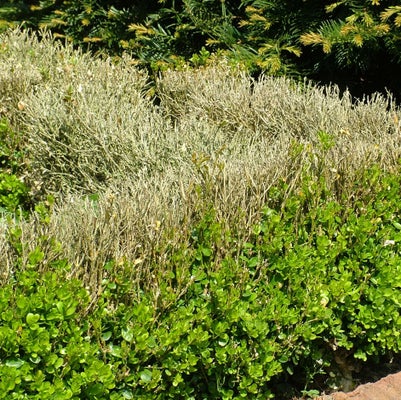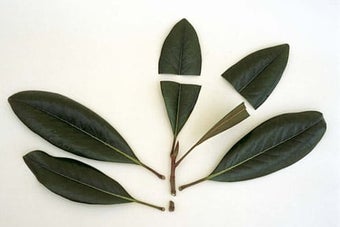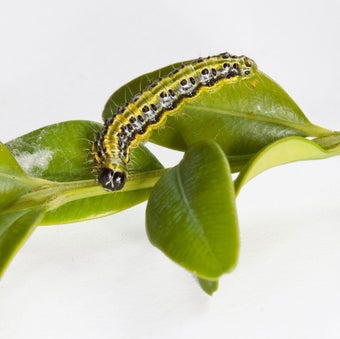
Quick facts
Common name - Box blight
Scientific name - Calonectria pseudonaviculata and Calonectria henricotiae (syn. Cylindrocladium buxicola)
Plants affected - Buxus spp. (box)
Main symptoms - Brown leaves and bare patches
Caused by - Fungus
Timing - All year round, but most active in rainy seasons
What is box blight?
Box blight is a disease of box leaves and stems caused by two closely related fungi, Calonectria pseudonaviculata and Calonectria henricotiae (syn. Cylindrocladium buxicola). The two species of Calonectria differ in their sensitivity to some fungicides (triazoles). They largely affect Buxus spp. (box) in the UK, but other plants in the Buxaceae family are also susceptible.
Box blight is just one of a number of problems box suffers from. A second blight, called Volutella blight, also affects the plant, but is less serious. Box in the UK is also increasingly affected by box caterpillar.
Symptoms
Correct diagnosis is important because of the effort involved in managing box blight. Try to catch it early, because the further advanced the epidemic, the harder box blight is to manage. You may see the following symptoms:
- Leaves turn brown and fall, leading to bare patches
- Black streaks and dieback on young stems
- In wet conditions, the white spore masses of the fungus may be seen on the undersurfaces of infected leaves (place leaves in a plastic bag with moist tissue for a few days to check). Note that spore masses of Volutella blight will look pink
- While box caterpillar also causes defoliation, this is distinguished by cobweb-like webbing, the presence of green and black caterpillars, and curved cut-outs in leaves from chewing

Control
The RHS believes that avoiding pests, diseases and weeds by good practice in cultivation methods, selection, and encouraging or introducing natural enemies, should be the first line of control. If chemical controls are used, they should be used only in a minimal and highly targeted manner.
Non-chemical control
If your garden is free of box blight, or you are yet to plant box, there are steps that you can take to minimise the risk of it arriving and to prepare the garden for its possible arrival. For more detailed information, see our page box blight: keeping it out.
Cultural control and hygiene
Hold any commercially sourced plants in isolation for at least four weeks to confirm they are free of infection before planting out. Commercial nurseries may use fungicides which suppress but do not kill the fungus, and this isolation technique will allow time for suppressed disease to become visible. Taking from healthy box in your garden will reduce the risk of introducing the disease.
Inspect plants for early symptoms as box blight spreads very rapidly in warm and humid conditions and is difficult to manage.
Reduce the frequency of clipping to create more throughout the plants (regular pruning creates dense foliage and less air movement). Prune a hedge with a convex top rather than flat and prune only in dry conditions. Clean pruning tools with a garden disinfectant or mild bleach solution between different areas of the garden and between gardens to minimise unwitting spread of the disease.
Avoid overhead watering as box blight thrives in humid conditions. Use under plants to reduce rain splash. Feed plants moderately.
Managing an outbreak
If the disease does break out steps should be taken to reduce its spread. Further steps can be found on our page box blight: managing outbreaks.
When conditions are dry;
- Dig up and destroy badly affected box plants or less important plantings, especially if trying to safeguard prized plantings
- Cut back or cut out affected parts of less severely attacked box plants or valuable specimens you are trying to save
- Remove fallen leaves from the centre and around the base of affected plants and strip off the surface of the topsoil. Infected material should be bagged to avoid dropping debris around the garden and binned (not composted)
Feed plants that have been cut back with a general purpose fertiliser to aid recovery.
Choose alternatives to box, or try a cultivar with claimed resistance to the disease
To be completely safe, choose an alternative hedge or topiary plant. Read our guide to choosing box alternatives, and then browse our box alternatives selection page to find a plant that works for you.
There are differences in susceptibility to box blight between different box species and cultivars. Some newer cultivars claim to have good resistance to the disease and could be tried where it has been a problem, or if you are planning to use box in your garden:.
- Common box and the dwarf form B. sempervirens 'Suffruticosa' (popular for parterres) are very susceptible
- In general the cultivars of B. microphylla are less susceptible than cultivars of B. sempervirens
- Based on work done in Belgium, cultivars 'Babylon Beauty',‘Faulkner’, 'Heritage', 'John Baldwin', 'Belvédère', 'Rococo', 'National', 'Renaissance','Skylight' and 'Trompenburg' are less susceptible to the disease. Not all of these cultivars are widely available in the UK yet.
Fungicides
The RHS recommends that you don't use fungicides. Fungicides (including organic types) may reduce , impact soil health and have wider adverse environmental effects. If you do intend to use a fungicide, please read the information given in the link and download below to ensure that use, storage and disposal of the product is done in a responsible and legally compliant manner.
The products listed in the ‘Fungicides for gardeners’ document below are legally available for use by home gardeners in the UK. This information is provided to avoid misuse of legal products and the use of unauthorised and untested products, which potentially has more serious consequences for the environment and wildlife than when products are used legally. Homemade products are not recommended as they are unregulated and usually untested.
Preventative fungicide applications can be made 7 to 10 days before trimming and 7 to 10 days after trimming where there is a high risk of box blight. However, fungicides are unlikely to be effective against box blight unless combined with the other control strategies outlined above.
Download
Fungicides for gardeners (Adobe Acrobat pdf document outlining fungicides available to gardeners)
Link
Biology
Calonectria pseudonaviculata and C. henricotiae can survive as resting structures or mycelium on fallen leaves for up to 6 years and produce spores (inoculum) when conditions are suitable. The spores are dispersed in water and probably by animals and birds. They may be spread in wind-blown rain, but are unlikely to travel long distances on the wind.
As well as natural means of dispersal, they have been spread widely by human activity, especially on infected plants from nurseries. Both species can infect unwounded plants and cause serious damage.
C. pseudonaviculata was first recognised in the UK in the mid 1990s and has also broken out in continental Europe, New Zealand and more recently in USA and Western Asia (Iran), but its origin is unknown. C. henricotiae was identified more recently and is currently only recorded in the UK and parts of mainland Europe.












